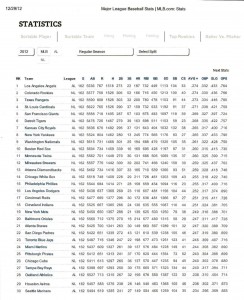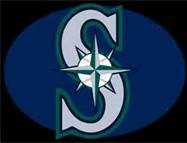Being a Mariner fan…wow…I don’t know that I would even wish it on someone I disliked intensely. But here I am…stuck with them, and I have resigned myself to sink or swim with them. No ship jumping for me; I will suffer through whatever I must to see the day that they bring a World Series to Seattle and win it. I figure it will be that much sweeter because I will have paid my dues as a fan. But…boy do they make it hard; and though I may suffer, don’t expect me to be quiet about it. So here it is…my unsolicited take on the Mariners off season moves so far this winter.
If you haven’t been paying attention I am reluctant to be the harbinger of bad news. The winter meetings are over, we are 6 weeks from pitchers and catchers and so far the biggest moves the Mariners have made are a new $10,000,000 score board, raising the ticket prices and bringing in the fences at Safeco Field. After years of losing and last place seasons, raising the ticket prices while giving us a new score board kind of speaks volumes about where the guys running this team are at. Keep the $10,000,000 and the old score board guys… use the dough to cover whatever the reason is you are raising ticket prices and leave the prices where they are. The fans don’t give a hoot about a new score board…what we want is wins!
What really galls me though, is bringing in the fences. On the face of it this is a gesture made with the hopes of improving the Mariner offense; an offense that has set new standards for futility over the last few seasons. Well…it won’t work and for a very simple reason; the location of the fences is NOT the reason for the Mariners offensive woes. I think the reason they are doing it is that someone observed that this batch of Mariners hit better on the road than they did at the Safe or listened to Justin Smoak bitch about how he had crushed that pitch that was just caught on the warning track, and so decided on bringing in the fences as the solution.

It is no solution. If the Mariners hitters are “psyched out” by Safeco Field’s dimensions the problem is their “psyche” not the dimensions of the field. As a fan I am REALLY tired of the kind of “logic” exhibited by actions like “bringing in the fences” because it gets us no closer to winning a World Series. To fix anything that is non optimum, like the Mariner’s offense, you must find and address the actual cause and not things that are mere explanations. To do this you must have data. So…since the Mariners seem unwilling to do it, let’s you and I examine some.
First, let me point out the obvious fact that that in bringing in the fences for the Mariners at Safeco you are also bringing in the fences for the other team as well. Whatever help this will be to the Mariner offense will benefit the opposing team’s offense equally. How this is helping the Mariners win games is lost on me. But that is a minor point. The major point is that just 11 years ago in 2001, hitting in the same Safeco Field with the same dimensions, the Mariners had the number one offense in the American League! They led the league in runs scored (927), hits, batting average (.288) and on base percentage (.360). They were number two in walks with 614. In addition, in the 14 team American League they were 6th in doubles, 2nd in triples and 8th in home runs. That team won more games (116) than any team in the Major Leagues since the 1906 Cubs, and all in the same ball park with the same dimensions that the current team finds to be such a burden. How could they do this? Well…the purpose of the human mind is to solve problems relating to survival…so let’s use it! (something the Mariners management would be well advised to do)
The 2012 edition of the Seattle Mariners, though actually improved on offense from the year before, pale in comparison to the 2001 team in nearly every offensive statistical category. They scored 619 runs (300 fewer), had a Major League worst team batting average of .234, walked 466 times and had a team on base percentage of .296 (the worst in Major League baseball). When you realize that the purpose of offense in baseball is to score runs and that to score runs you must get on base then you can start to see why “on base percentage” is such a key statistic and much more important at measuring offensive effectiveness than “batting average”. (“On base percentage” is calculated by taking the number of times a player reaches base—excluding reaching by fielder error, fielder’s choice, dropped third strike or catcher obstruction—whether by hit, hit by pitch, by walk or whatever, and divides by the player’s total at bats. An OBP of .300 simply means the player reached base 3 times for every ten at bats). The top teams in scoring runs last year in the Major Leagues were Texas (808), Yankees (804), Milwaukee (776), Angels (767), and St. Louis (765). These teams were also among the leaders in team OBP, and all had winning records with St. Louis and the Yankees making the playoffs and the Angels and Texas in the race until the season’s last day. The two teams making it to the World Series, Detroit and San Francisco, also had team OBPs in the upper third of Major League teams. Incidentally, to illustrate how great that 2001 Mariner team was in the same Safeco Field that the current Mariners find to be such a problem, that Mariner team scored 100 runs more than the BEST team in the Majors in 2012 (Texas) and had an OBP of .360, more than 20 points higher than the best Major League OBP team in 2012, the St. Louis Cardinals at .338. It was no accident that 2001 team won 116 games…they made appoint of getting on base.
It is also apparent from a study of the data, that there is a distinct correlation between OBP and batting average. In general this could be summed up as “the higher the OBP, the higher the batting average”. The 2012 Mariners had the worst team OBP (.296) AND the worst team batting average (.234) in the Majors. The top teams in OBP also tended to be the top teams in average AND the top teams in scoring runs, as can be seen in this chart of 2012 team statistics from MLB. (To view click on the image)

Look it over and draw your own conclusions. And while you might think that this is all “sabermetrics, Bill James and Baseball Abstract” stuff, in truth it really isn’t. Ted Williams, by the reckoning of some the greatest hitter ever, had it all figured out decades ago and summed it up in his book “The Science of Hitting” as “get a good pitch to hit”. A look at Williams’ career stats shows that he practiced what he preached; they are nothing short of eye popping! Despite missing nearly all of 5 peak potential seasons due to service in World War II and Korea, Williams’ production speaks for itself; a career .344 batting average; .488 OBP (highest in ML history!) and 521 career home runs. “The Splendid Splinter”, as Williams was called, across his career averaged 143 walks per 162 game season!! The guy simply did not swing at bad pitches… and because of this, to get him out, the pitcher had to throw him strikes; and when the pitcher threw him strikes Ted simply squared them up and hit them…that’s it and that’s all.

By comparison the top Mariner in walks last year was Dustin Ackley with 59 in 600 plus at bats. Ackley’s OBP was a meager .294. Want to know who number two for the Mariners in walks was? The answer is very enlightening…John Jaso with 56! Jaso walked nearly as many times as Ackley in half the at bats Ackley had! As a result Jaso led the team in OBP (.394) AND batting average (.276). Clearly Jaso was not “psyched out” by Safeco Field dimensions like the rest of the Mariners apparently are. (My question is why didn’t Jaso get more at bats?)
What is the key, then, to getting a high OBP and resultant batting average, runs scored, and wins? They key is plate discipline by the hitter; don’t swing at bad pitches, square up the good ones and if the pitcher won’t throw you good ones take your base via the walk. When you have a team of players that concentrate on this you win. Simple right?
Of course there are many other factors to baseball; some players have more talent and some less and pitching and defense have their parts in things. Hitting Major League pitching is not easy; if it was, as the saying goes, everyone would do it. But the Mariners make it way tougher on themselves than it needs to be in my opinion. The answer to improving our team is not contained in moving in the fences, new score boards and such illogical actions. The answer is contained in the lessons to be learned by a study of the data above.
Hint to Mariners: you want to really improve the team’s offense in 2013? Have all the players study John Jaso’s 2012 at bats and read Ted Williams’ “Science of Hitting”. Preach “get a good pitch to hit” and use batting practice to drill, drill, drill it until the players all grasp it conceptually and are practicing it at the plate. Do this and the Mariners will get better and be a more exciting and fun team to watch and…who knows…we might even make the playoffs and get that World Series at long last.
by Mark Arnold
Copyright © 2012
All Rights Reserved


